

Example risk assessment for a hairdressing salon: case study. Important reminder.
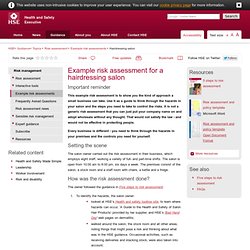
HSE - Hairdressing: Case studies. Tracy Tracy has been in the hairdressing industry for 17 years, and now runs her own salon in Yorkshire, employing eight members of staff.

A few years ago, Tracy employed a new hairdresser who suffered from dermatitis. She contacted her local council for advice, and they told her about ‘Bad Hand Day?’ And the five simple steps for preventing dermatitis becoming a problem. Tracy had always provided gloves for use when colouring hair, but she now introduced a salon policy for staff to wear them for all hairdressing tasks, including shampooing and cutting hair. In order to avoid significant costs, Tracy now supervises her staff to ensure they follow the salon policy. Tracy says that her team find the longer length non-latex gloves that HSE recommend comfortable. For her efforts, Tracy’s salon has won the regional award for good practice in the Habia Health & Safety Awards scheme for the past two years running. Suzanne Suzanne Willis has been a hairdresser since 2000. Bonny Lucy. Sr11.
Risk management: Principles and guidelines to assist HSE. Introduction 1.
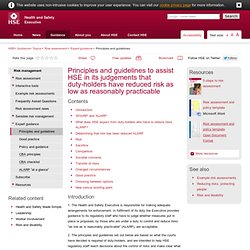
The Health and Safety Executive is responsible for making adequate arrangements for enforcement. In fulfilment of its duty the Executive provides guidance to its regulatory staff who have to judge whether measures put in place or proposed, by those who are under a duty to control and reduce risks "as low as is reasonably practicable" (ALARP), are acceptable. 2.
The principles and guidelines set out below are based on what the courts have decided is required of duty-holders, and are intended to help HSE regulatory staff reach decisions about the control of risks and make clear what they should expect from duty-holders. 3. 4. Risk management: Good practise. 1.

Scope 1.1 The Health and Safety Executive is responsible for making adequate arrangements for the enforcement of health and safety legislation in the UK. In fulfilment of its duty, the Executive provides guidance to its regulatory staff who have to judge whether measures put in place, or proposed, by those who are under a duty to control and reduce risks “as low as reasonably practicable” (ALARP), are acceptable. Risk management: Principles of sensible risk management.
Risk management: Principles of sensible risk management. Despite the stories you hear, the HSE is about saving lives, not stopping people living.
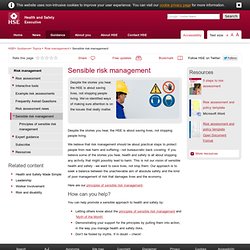
We believe that risk management should be about practical steps to protect people from real harm and suffering - not bureaucratic back covering. If you believe some of the stories you hear, health and safety is all about stopping any activity that might possibly lead to harm. This is not our vision of sensible health and safety - we want to save lives, not stop them.
Our approach is to seek a balance between the unachievable aim of absolute safety and the kind of poor management of risk that damages lives and the economy.
Essentials. Example risk assessment for a hairdressing salon: case study. This is the statement of general policy and arrangements for: Risk management: Five steps to risk assessment. This is not the only way to do a risk assessment, there are other methods that work well, particularly for more complex risks and circumstances.
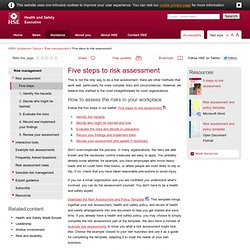
However, we believe this method is the most straightforward for most organisations. Follow the five steps in our leaflet: Five steps to risk assessment Don’t overcomplicate the process. In many organisations, the risks are well known and the necessary control measures are easy to apply. You probably already know whether, for example, you have employees who move heavy loads and so could harm their backs, or where people are most likely to slip or trip. Risk management: Review your risk assessment and update if necessary. Risk management: Step 4: Record your findings and implement them.
Putting the results of your risk assessment into practice will make a difference when looking after people and your business.
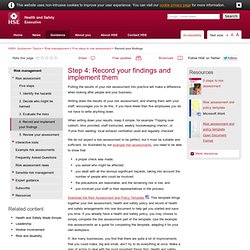
Writing down the results of your risk assessment, and sharing them with your staff, encourages you to do this. If you have fewer than five employees you do not have to write anything down. When writing down your results, keep it simple, for example ‘Tripping over rubbish: bins provided, staff instructed, weekly housekeeping checks’, or ‘Fume from welding: local exhaust ventilation used and regularly checked’. Risk management: Step 3: Evaluate the risks and decide on precautions. Having spotted the hazards, you then have to decide what to do about them.

The law requires you to do everything ‘reasonably practicable’ to protect people from harm. You can work this out for yourself, but the easiest way is to compare what you are doing with good practice. First, look at what you’re already doing, think about what controls you have in place and how the work is organised. Then compare this with the good practice and see if there’s more you should be doing to bring yourself up to standard. In asking yourself this, consider: Can I get rid of the hazard altogether? When controlling risks, apply the principles below, if possible in the following order: Risk management: Step 2: Decide who might be harmed and how.
For each hazard you need to be clear about who might be harmed; it will help you identify the best way of managing the risk.
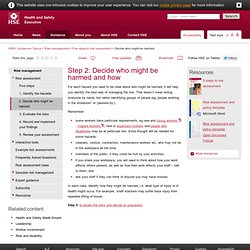
That doesn’t mean listing everyone by name, but rather identifying groups of people (eg ‘people working in the storeroom’ or ‘passers-by’). Remember: some workers have particular requirements, eg new and young workers [1], migrant workers [2], new or expectant mothers[3] and people with disabilities[4] may be at particular risk. Extra thought will be needed for some hazards; cleaners, visitors, contractors, maintenance workers etc, who may not be in the workplace all the time; members of the public, if they could be hurt by your activities; if you share your workplace, you will need to think about how your work affects others present, as well as how their work affects your staff – talk to them; and ask your staff if they can think of anyone you may have missed.
In each case, identify how they might be harmed, i.e. what type of injury or ill health might occur. Risk management: Step 1: Identify the hazards.